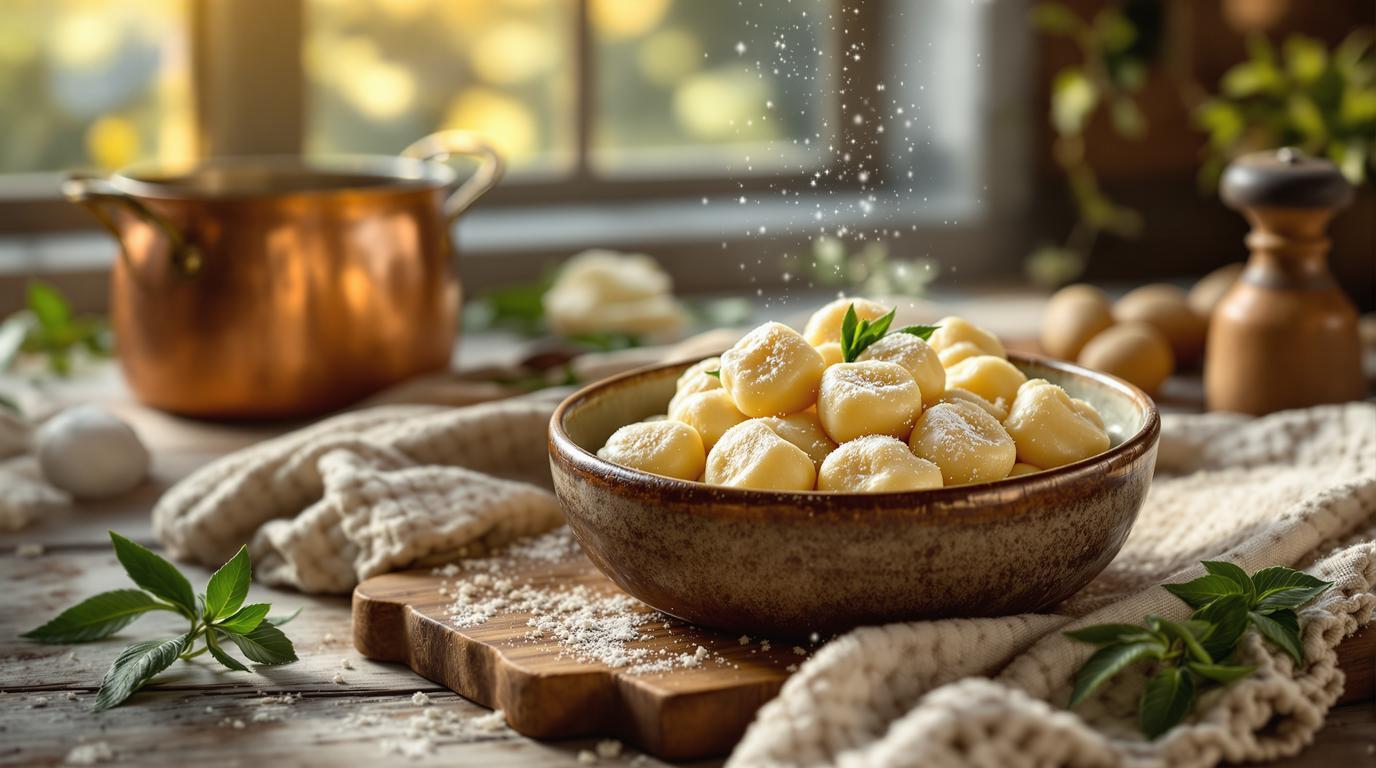There’s something magical about potato gnocchi that takes me back to my grandmother’s kitchen in northern Italy. As a young boy, I would watch in awe as her weathered hands transformed simple potatoes into pillowy clouds that practically floated in sauce. “The secret is in your touch,” she would whisper, showing me how to press each dumpling gently against a wooden fork. This humble dish perfectly illustrates why Italian cuisine is both unified and gloriously diverse – while ingredients and methods vary from Piedmont to Sicily, the reverence for tradition and quality remains constant. 🇮🇹
The Story Behind Traditional Gnocchi 📖
Gnocchi originated in Northern Italy as peasant food, born from necessity when wheat was scarce. The name comes from “nocchio,” meaning a knot in wood, describing their rustic appearance. While potato gnocchi is most common today, early versions used breadcrumbs, squash, or even chestnut flour. Each region developed its own variation – lighter and ricotta-based in Tuscany, heartier and potato-forward in Piedmont. What unites them is the careful technique passed through generations, proving that Italian cuisine isn’t just a collection of recipes but a philosophy of cooking with what’s local, seasonal, and available. 🥔
Essential Ingredients 🧾
The beauty of authentic gnocchi lies in its simplicity – just four ingredients create something extraordinary:
- 2.5 lbs (1.1 kg) starchy Russet potatoes
- 2 cups (250g) “00” flour, plus extra for dusting
- 1 large egg
- 1 teaspoon (5g) salt
Each ingredient plays a crucial role: potatoes provide the base, flour binds the dough, egg adds richness, and salt enhances flavor. If you can’t find “00” flour, all-purpose works, though the texture won’t be quite as light. For a truly authentic experience, seek out aged potatoes – they contain less moisture and make for fluffier gnocchi. 🌟
Chef’s Note: Never use waxy potatoes like Red Bliss or Yukon Golds for gnocchi. Their high moisture content requires excessive flour, resulting in dense, gummy dumplings – a mistake I learned the hard way in my first restaurant kitchen!
Step-by-Step Instructions 📝
The process requires patience but rewards you with incomparable texture:
- Place unpeeled potatoes in cold, salted water. Bring to a gentle boil and cook until a knife pierces easily to the center, about 25-30 minutes. Cooking them unpeeled prevents waterlogging. 💦
- Drain potatoes and, while still hot (use a kitchen towel to protect your hands), peel and press through a ricer or food mill onto a clean work surface. Allow steam to escape for 5 minutes. 🔥
- Make a well in the center of the potatoes, add the egg and salt, and begin incorporating with a fork.
- Gradually sprinkle flour over the mixture, folding gently with a bench scraper until a soft dough forms. Stop adding flour the moment the dough no longer sticks to your hands – this is critical! 👐
- Divide the dough into 4-6 portions and roll each into a ½-inch (1.3 cm) thick rope on a lightly floured surface.
- Cut ropes into 1-inch (2.5 cm) pieces and roll each gently down the tines of a fork (or gnocchi board) to create ridges that capture sauce.
Chef’s Secret Techniques 🤫
The difference between good and transcendent gnocchi comes down to technique. Touch the dough as little as possible – overworking develops gluten, making gnocchi tough. The potatoes must be hot when mashed; cold potatoes require more flour, resulting in dense dumplings. And always test one gnocco before shaping the entire batch – if it falls apart in boiling water, gently work a bit more flour into your dough.
During my years cooking in Turin, I learned that many Italian grandmothers add a pinch of nutmeg to their dough – an optional but delightful enhancement that pairs beautifully with sage butter sauce. For those seeking additional flavor dimensions, try incorporating finely chopped herbs or a tablespoon of grated Parmigiano-Reggiano. 🌿
Serving & Presentation Tips 🍽️
Cook gnocchi in generously salted, gently boiling water until they float to the surface (about 2-3 minutes). Remove immediately with a slotted spoon – never let them boil vigorously or overcook. While modern recipes might suggest complex sauces, traditional Italian preparations honor the delicate texture with simple accompaniments:
- Brown butter with fresh sage leaves and a sprinkle of Parmigiano-Reggiano
- Light tomato sauce with fresh basil
- Gorgonzola cream sauce (a northern specialty)
Serve immediately on warmed plates – gnocchi waits for no one! For a complete meal, pair with bitter greens dressed simply in olive oil and lemon, balancing the richness. If you’re inspired by more quick homestyle recipes, consider serving alongside a simple protein.
My grandmother always said, “Good gnocchi needs nothing more than good company.” In her wisdom lies the essence of Italian cooking – simple ingredients transformed through technique into something that brings people together. Whether you’re making our quick homemade bread or these traditional dumplings, remember that Italian cuisine isn’t one thing – it’s hundreds of regional traditions unified by a reverence for quality ingredients and time-honored techniques. That’s the true magic of Italy’s culinary heritage. Buon appetito! 🍴
